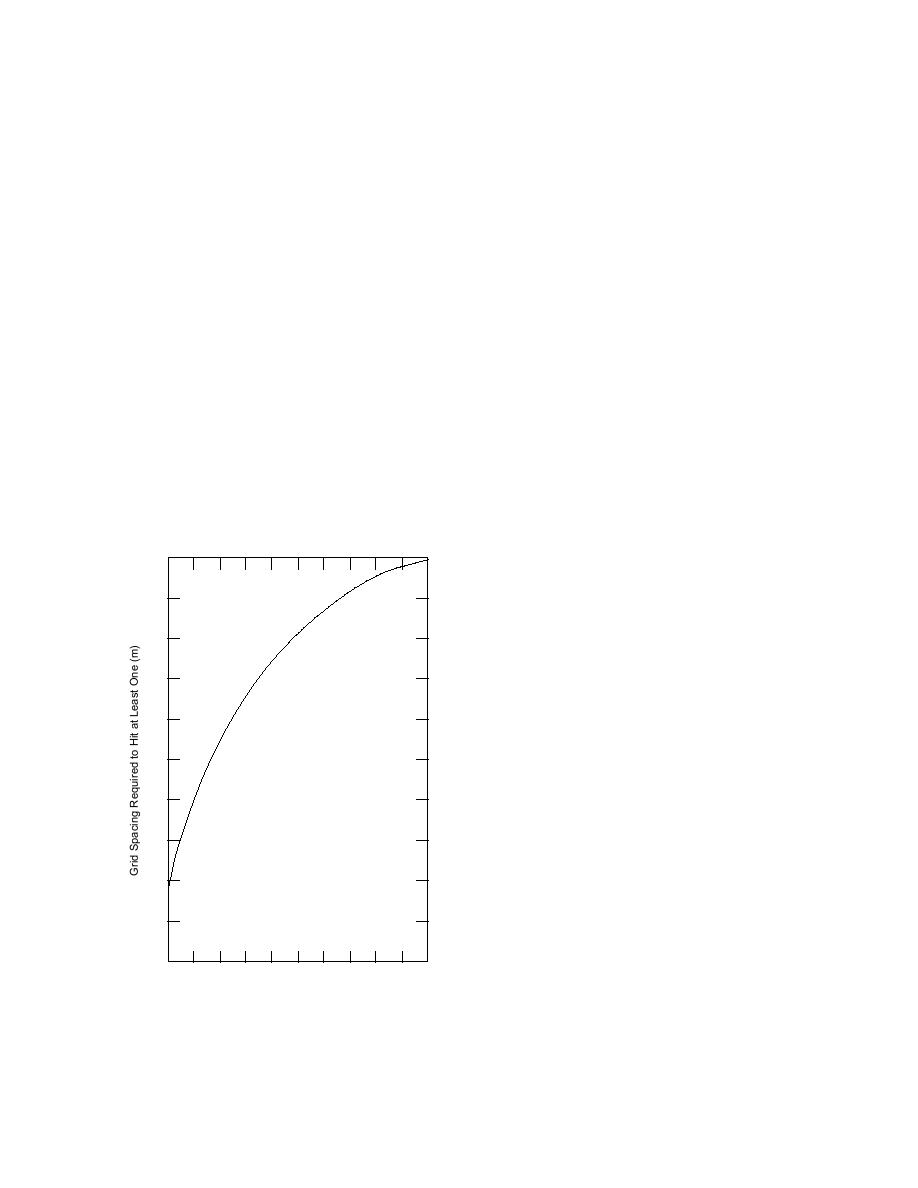
increase while maintaining an acceptable risk of
This requirement for such tight grid spacing
missing hot spots. For example, we set the proba-
emphasizes the importance of compositing sam-
bility of hitting zero of H hot spots to 10% (or
ples to reduce the total number of samples sub-
some other acceptable risk) and the binomial dis-
mitted for analysis. Because a single hot spot can
tribution simplifies to
contain enough white phosphorus to poison hun-
dreds of ducks, the prudent approach would be
Probability of hitting exactly 0 of H hot spots
to keep the grid spacing small (approximately 2
m). However, for a large area, a compromise
= 0.1 = βH for H = 1, 2, 3 ...
would still be necessary between a low risk of
missing hot spots and the number of samples that
Then, solving for β, we see that
is affordable.
For a large pond that is known to be contami-
β = (0.1)(1/H) .
nated and is being subjected to a remedial treat-
ment, the area could be divided into sections.
Going back to the operating curve relating L/G
Composite samples representing each section
to risk β (Fig. 2), we can calculate G, the grid spac-
could be formed by collecting discrete samples at
ing needed to maintain a 90% chance of hitting at
2-m intervals along transects through each sec-
least one hot spot. Results of this calculation for H
tion. Ideally, the same sampling approach would
= 1, 2, 3, ...15 (Fig. 9) shows that the grid spacing
be conducted before the start of remediation and
needs to be on the order of a few meters to find at
used iteratively to monitor it. The assumption
least one hot spot with a radius (L) of 1 m, unless
used would be that if the remedial process
the number of hot spots is large. Even if 100 hot
worked along the transect, it also worked for the
spots exist, the grid spacing can be no larger than
rest of the section.
10 m to find at least one hot spot 90% of the time.
CONCLUSIONS
10
When the need arises to determine the level of
9
white phosphorus contamination in an area, com-
posite sampling as described in this report is a
cost-effective alternative to exhaustive discrete
8
sampling and analysis. The stirred compositing
approach provides concentration estimates with
7
greater precision than discrete samples. It may be
used to rank areas in terms of contamination level
6
and permit monitoring of the decline in contami-
nation after a remedial action. The sieved com-
5
positing approach may be used to determine if
waterfowl-available white phosphorus is present
in an area.
4
3
LITERATURE CITED
Clark, L., and J.L. Cummings (1994) Field behav-
2
ioral response and bead formulation for methyl
anthranilate encapsulated bird repellents. In
1
Interagency Expanded Site Investigation. Evaluation
of White Phosphorus Contamination and Potential
Treatability at Eagle River Flats, Alaska (C.H. Racine
0
0
10
20
30 40 50 60 70
90 100
80
and D. Cate, Ed.). FY93. USA Cold Regions Re-
Number of Hotspots (H)
search and Engineering Laboratory Contract Re-
Figure 9. Effect of the number of hot spots on the
port to U.S. Army Garrison, Alaska, Directorate
grid size designed to detect at least one hot spot
of Public Works, Final Report, p. 281294.
with a radius of 1 m while maintaining a 10%
Exner, J.H., W .D. Keffer, R.O. Gilbert, and R.R.
risk of not hitting any hot spots.
Kinnison (1985) A sampling strategy for remedial
17




 Previous Page
Previous Page
